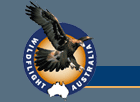|

|
|
Common wombat
A wombat emerges from her burrow after sunset in south-eastern Australia.
Often seen during the day browsing on sedges at the base of the sand hills
near home. This animal took its own photograph with the aid of an electronic
trigger.
Lens 55 mm.

|
 |
P0014
|
Dingo pups
Dingo pups engage in a tug of war with a piece of bark next to a waterhole.
Lens 300 mm.

|
 |
|
Koala twins
Twin Koalas cling to their mother. This is a rare event.
Lens 55 mm.
|
 |
R0045
|
Merino lambs
Merino lambs are associated with Australia's drier country, but this pair
decided to drink in the middle of a shallow swamp. Photographed from a
hide. Hot and thirsty young sheep will often swim through the middle of
a dam.
Lens 80 mm.
|
 |
|
Pearson-Island rock-wallaby
The rock-wallaby on Pearson Island live on salt bush and other scarce
plant material and are forced to live in close proximity to the sea. The
earmarks in older animals are testimony to continual battles for survival.
Lens 300 mm.
|
 |
P0001
|
Platypus
A platypus shelters beneath an overhanging branch while eating. This animal
has to swim constantly to stay beneath the surface or wedge itself under
a log or rock otherwise it pops to the surface like a cork.
Lens 80 mm.
|
 |
|
Wombat
A common wombat wedges her offspring, 'in great tightness', as she rakes
nesting material in to her burrow with her front paws. She first windrowed
the material before backing towards the burrow with armfuls of bark and
leaves.
Lens 200 mm.
|
 |
M0061
|
Red fox
A feral red fox followed close behind as I walked along a valley in the
Flinders Ranges. It must have had little contact with humans as it continued
to approach as I lay on the ground aiming the camera. She then just sat
down and watched me from 5 meters away. A beautiful animal, but we'd be
better off without it in Australia.
Lens 300 mm.
|














